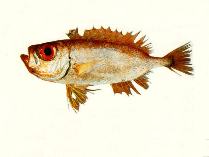| Family: |
Priacanthidae (Bigeyes or catalufas) |
| Max. size: |
18.5 cm SL (male/unsexed) |
| Environment: |
demersal; marine; depth range 150 - 400 m |
| Distribution: |
Western Pacific: southern Japan to northwestern Australia. |
| Diagnosis: |
Dorsal spines (total): 10-10; Dorsal soft rays (total): 13; Anal spines: 3-3; Anal soft rays: 13-14. Medium-sized fish. The body is oval; dorsal fin continuous; eyes very large; mouth large and oblique, with the lower jaw projecting upwards. The head and body silvery red or pink; iris of eyes red. The fins are creamy pink; the last 4-5 soft rays of the dorsal and anal fins are clearly white. This species resembles P. macracanthus with a long and narrow preopercular spine, but has less body depth, a narrower caudal peduncle, and fainter yellowish spots on its dorsal, anal and pelvic fins. |
| Biology: |
A deeper water species trawled from relatively open bottoms at depths of 150 to over 400 m. |
| IUCN Red List Status: |
Not Evaluated (N.E.) Ref. (130435)
|
| Threat to humans: |
harmless |
Source and more info: www.fishbase.org. For personal, classroom, and other internal use only. Not for publication.

